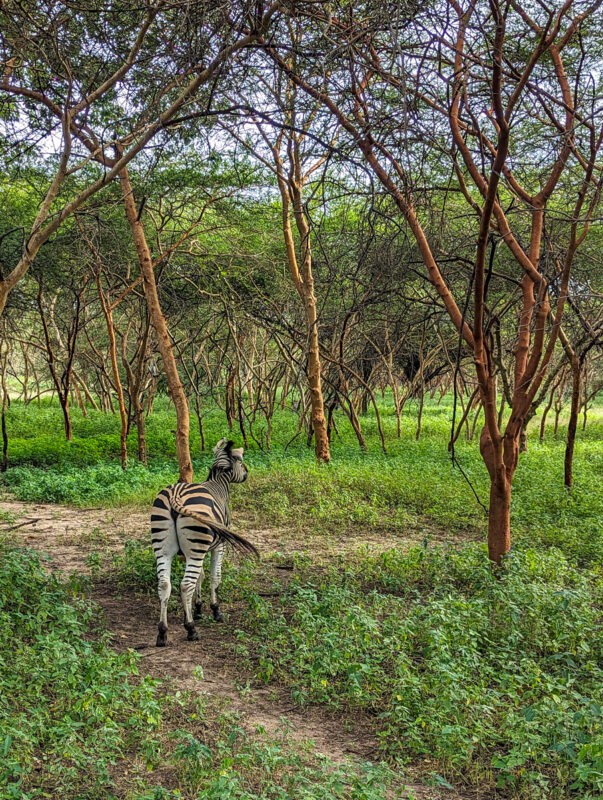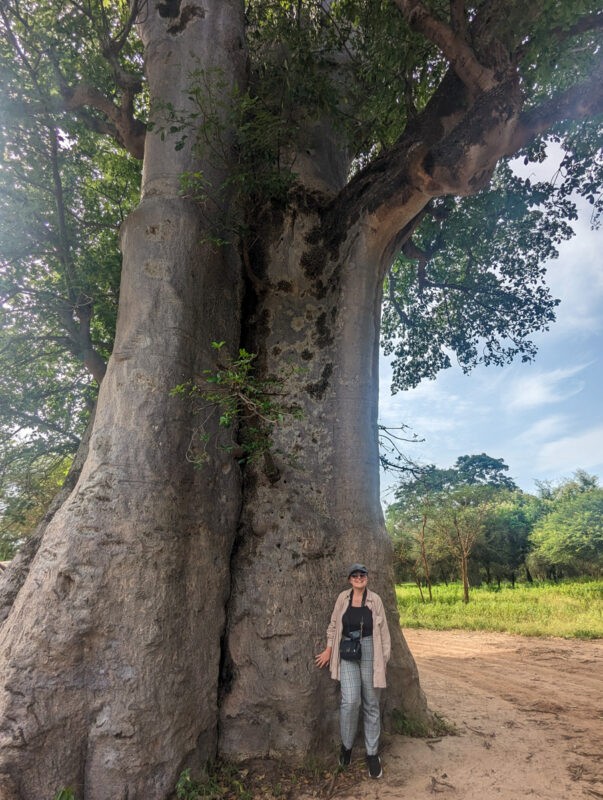I did a few safaris in Senegal on my recent trip to the country. Here’s what I made out of them and what to expect if you go on one!
“We have one rhino, I named him Kevin”, Mamadou, our safari guide, informed us. “Hopefully we’ll see him today!”
We were on a bush drive in Fathala Wildlife Reserve, one of the most renowned safari parks in West Africa.
But, before visiting Senegal, I didn’t know that such a place existed. Aren’t safaris more of an East or Southern Africa thing?
Well, yes, they are – but a few nature reserves across Senegal (and in other places in West Africa) are opening up, some focusing on their own native nature, others introducing or re-introducing animals.
Does Senegal have safaris?
Yes, Senegal has safaris.
To clear up any confusion, let’s look at the definition of a safari.
The Cambridge dictionary says it’s: an organized journey to look at, or sometimes hunt, wild animals, especially in Africa.
Note: especially in Africa, not exclusively!
Technically, we have “sea safaris” near where we live on the North Cornwall coast (to look out for seals and birds, rather than giraffes and rhinos!).
What are safaris in Senegal like?

While Senegal does have safaris, they aren’t as “wild” as those in East Africa.
You don’t have a vast savannah where giraffes and lions wander over – don’t expect the Great Migration!
But what it does have are reserves of various sizes where they have re-introduced animals (rhinos, giraffe, zebra and antelope all used to live in Senegal, but they became extinct).
This is a similar set-up to national parks in South Africa, although admittedly, the South African equivalents are a lot bigger (Kruger is over 19000 km² compared to Fathala in Senegal which is 60km² – although the lesser-visited Senegalese Nikolo-Koba National Park is 9000 km²).
I haven’t done an East African safari, so I cannot compare the two.
But I will say that Bandia reserve, with limited tracks, felt a little more claustrophobic and “zoo-like”, whereas Fathala didn’t – it seemed like there was much more space and it felt like we were going deep into the bush on gnarly roads before we spotted some animals.
Where to go on safari in Senegal
The three main places to go on safari in Senegal are: Bandia Wildlife Reserve, Fathala Wildlife Reserve and Nikolo-Koba National Park.
Bandia Wildlife Reserve

Sitting equidistant from Dakar and the beaches of Senegal’s Petite Cote, Bandia Wildlife Reserve is certainly convenient.
If you drive to the park independently, you can hop in a safari jeep for just 18, or drive your own vehicle (if it’s appropriate for the terrain) with a guide for even cheaper.
The park is famous for its guaranteed sightings of zebra, giraffe, antelope and monkeys – and almost guaranteed rhino sightings.
But of course, this is because the safari reserve is really quite small – the smaller the area, the more likelihood you have of finding animals on safari.

They also keep the hyenas in enclosures, as they are a natural predator. This felt quite unnatural, although as it means that the other animals in the nature reserve don’t have any natural predators, they must have quite a relaxed life!
All that said, I did very much enjoy my safari here. It was my first experience of this type of safari, I adored seeing the elegant giraffes and graceful antelope.
If you regularly do safaris in the Kenyan savannah, you might be disappointed, but if not, I do think it’s well worth visiting the Bandia Wildlife Reserve.
Fathala Wildlife Reserve

That said, if you only want to visit one wildlife reserve on your trip to Senegal, I’d make it Fathala.
Fathala has everything Bandia has, but better. The tracks are more rugged, nature more raw, the animals (when you find them) more at home.
Like in Bandia, wild animals were re-introduced to Fathala after being made extinct centuries ago.
The land is Senegalese-owned, but the lodge is run by a South African company, who transported animals from their native country to repopulate the park.
Things to do at Fathala
Nowadays, day visitors usually embark on a two-hour game drive, trundling deep into the park to see as many animals as possible. It’s usual to see most of the large animals – although Kevin the rhino can be a little elusive (we didn’t see him on our game drive, but he was waiting for us when we got back to the lodge!).
Lodge guests can also enjoy bush walks and mangrove boat tours.
Then there’s also the opportunity to walk with lions. We didn’t do this for a couple of reasons.
I don’t agree with keeping lions like this; apparently, they were looked after by humans from a young age which is why they are docile. But in my opinion, they’re still wild animals, and I’d a) be too concerned about walking with them myself and b) don’t wish to support having them in captivity.
Fathala Wildlife Reserve Lodge

We stayed at the Fathala Wildlife Reserve Lodge for two nights, and it was easily one of the best hotels I’ve ever stayed in.
Accommodation is in a traditional safari tent, with a ridiculous amount of mod-cons (air conditioning, free-standing bath, fridge and an uber-comfy bed to name but a few!).
As soon as I unzipped my tent, I was right in the heart of nature, with monkeys outside on the terrace and the sound of birdsong in the air.
The tents are centered around an airy reception area, with a swimming pool, bar and restaurant. The food was top-notch; everything was prepared to perfection, with decent vegetarian options.
Service was top-tier as well.
Nikolo-Koba National Park
I didn’t get a chance to visit Nikolo-Koba National Park, which is right in the southeastern corner of Senegal, but it’s supposed to be the “wildest” safari experience you can get in the region. There are even lions here!
However, it’s difficult to visit without a tour. If you do want to go, I’d recommend contacting my friend Omar from OmiTours; he’s based in The Gambia offers tours all over West Africa and would definitely be able to help you out.
Animals you might see on a Senegalese safari
So, what can you expect to see on a safari in Senegal? Look out for the following:
Giraffe

We saw a few of these towering in both Bandia and Fathala. They’re incredibly graceful!
Zebra
Zebra usually move in packs, and we saw a collection of them on our game drives in both reserves. They were a little skittish of the cars, but I got some good photos.
Antelope
A few different types of antelope live on the safari parks in Senegal.
Western Giant Lord Derby Eland

This animal’s only found in Senegal and Mali! Fathala is one of only three places where they exist in the wild.
Warthog
We saw plenty of warthogs (aka Pumba from The Lion King) in Fathala. They’re much smaller in real life!
West African Crocodile
There are lots of West African crocodiles in the river in Bandia Wildlife Reserve – the viewpoint is far above – and we also saw one on our mangroves tour of Fathala.
Lions
Unless you do the walking with lions experience, you won’t see these creatures in Bandia or Fathala. However, you might locate them in Nikolo-Koba, if you’re lucky!
Hyenas
Hyenas are enclosed in Bandia Wildlife Reserve and there aren’t any in Fathala.
How to book your Senegal safari experience

Most tourists do Senegal safaris as part of a guided tour.
There are some tours available on Viator and Get Your Guide, but they’re pricey.
The cheapest option by far is to join a group tour from the major hotels on the Petite Cote. For example, if you stay at a TUI hotel like the Hotel RIU Baobab, you can book this tour.
If you aren’t staying at a TUI hotel, you can book with Nouvelles Frontieres who offer pick-up from other parts of the coast.
To see Fathala, most tourists actually do day trips from The Gambia. However, I’d highly recommend spending a couple of days at the lodge (bookable on their website) and enjoying activities from there.
To reach the lodge, you can take taxis, or catch various buses and sept-places to Kaolack and then connect to Toubakouta, then take a taxi to Fathala – this is what we did and it wasn’t too challenging!
Are you ready for a Senegalese safari?
It’s not quite the same as an East African safari, but provided you manage expectations, it’s entirely possible to see wild animals in Senegal!

